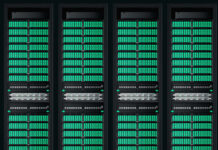StorMagic sells its virtual SAN product to edge IT sites and SMBs, not enterprise datacenters, and has no ambitions to go beyond these particular on-premises markets.
Although the virtual SAN technology coming from this software-defined storage supplier is always part of a hyperconverged infrastructure (HCI) setup, StorMagic does not class itself as an HCI supplier. That’s because the company does not supply a hypervisor, and its SvSAN software works with the vSphere, Hyper-V, and KVM hypervisors. Its product is an HCI component, not an HCI system.

Bruce Kornfeld, chief marketing and product officer, briefed Blocks & files on StorMagic’s market situation and strategies. The company was co-founded in Bristol, England, by CEO Hans O’Sullivan and CTO Chris Farey in 2011. Sullivan resigned in 2020 and Dan Beer became the CEO. Kornfeld told us that SvSAN supports x86 servers and only needs two of them to work as a high-availability clustered block storage system at edge sites, employing a remote witness to help with failover. The two servers can be mismatched in performance and configuration, SvSAN will still work.
The remote witness is a third server system-level application that selects one of the pair of servers at an edge site to function as the main server when the network link between the two edge site servers is broken. StorMagic can support thousands of edge sites and its minimal server hardware requirements increasingly help lower costs as edge site numbers grow. Kornfeld said: “With StorMagic, it’s just two servers, one virtual CPU, one gigabyte of RAM, one gigabit Ethernet, and away you go.”
SvSAN software is mature and proven, with StorMagic having more than 2,000 customers, with tens of thousands of sites, in more than 70 countries worldwide. It competes with VMware’s vSAN, Nutanix, and Scale Computing, which also sells hardware and software to edge sites and SMBs.
Kornfeld said of competition with Scale Computing: “[There’s] some, but they’re not the biggest competitor that we still have in the market [which] is VMware vSAN. We run into Scale Computing; they do a really good job, they’ve got a great solution there. What they’ve done is they’ve built their own hypervisor, which is good for many customers, because they just want their own thing and not have to worry about it. But a lot of customers aren’t ready to make that jump to learn something new. They want to be integrated into the environment they have. And we support Microsoft, VMware, and an open KVM as well. We tell our customers whatever hypervisor you want, we’re going to support you with a rock-solid hyperconverged storage solution.”
Competition with vSAN is being helped by Broadcom’s acquisition of VMware and its channel changes. Kornfeld told us: “With what’s happening with VMware and Broadcom, we’re starting to see even more desire from customers to use non-VMware hypervisors. So we think Hyper-V as well as KVM solutions will start to see more play.
“There are thousands and thousands of VARs around the world that sell to SMBs that now won’t have Broadcom channel partner status. So we’re getting a lot of inquiries from them.”
A major issue with Broadcom concerns VMware licensing. Kornfeld said: “They did a cold, hard stop on perpetual licensing … They’re forcing everyone to subscription. And we have a perpetual model that customers love. It’s low cost, you pay for the software once, you pay us annually for some support.
“We have a very low cost, perpetual license model,” he said. “It starts at $1,500 … It’s a great low-cost way for VARs to build solutions.”
We asked Kornfeld about support for Arm-based server hardware, and he said: “Our software is portable to Arm. And that is something that we debate here and there because at the edge … Arm is really starting to gain hold. But that’s something we haven’t tackled yet. That’s on the future to-do list.”
AI at the edge is not one of those customer requirements that StorMagic needs to support directly. Kornfeld said: “We are seeing AI driving significantly more data at the edge and at SMB sites … Many customers can’t wait to send data from the edge to the cloud to go and run analytics [there] and then sending answers back to the edge. We’re seeing it for sure. But our software doesn’t have to change to support it. They can put a GPU in any server they want. They can run any application, any analytics application they choose, whatever vertical market they’re in. And our product still works.”
However, AI could be used inside the SvSAN product, as Kornfeld revealed: “Without cornering me on release dates, I’ll just say that is an area that we’re looking at inside of our product, right?”
Our impression of the main current marketing activity for StorMagic is capitalizing on Broadcom’s enterprise and datacenter focus for VMware and its channel reorganization. It can realistically hope for a sales boost from refugee vSphere edge and SMB channel partners and expanding its worldwide sales footprint. Broadcom’s loss might just be StorMagic’s gain.








